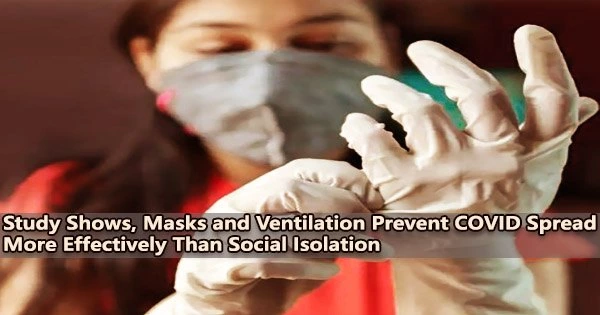According to a recent study from the University of Central Florida, social isolation may not be as effective as masks and a functioning ventilation system in preventing the airborne spread of COVID-19 in classrooms.
The study, which was just published in the journal Physics of Fluids, comes at a crucial moment as colleges and institutions consider offering more in-person classes in the next fall semester.
“The research is important as it provides guidance on how we are understanding safety in indoor environments,” says Michael Kinzel, an assistant professor in UCF’s Department of Mechanical and Aerospace Engineering and study co-author.
“The study finds that aerosol transmission routes do not display a need for six feet social distancing when masks are mandated,” he says. “These results highlight that with masks, transmission probability does not decrease with increased physical distancing, which emphasizes how mask mandates may be key to increasing capacity in schools and other places.”
In order to mimic airflow and disease transmission and determine the risk of airborne-driven transmission, the researchers built a computer model of a classroom containing children and a teacher.
“The classroom model was 709 square feet with 9-foot-tall ceilings, similar to a smaller-size, university classroom,” Kinzel says. The classroom’s front was occupied by a masked instructor, who could infect any of the model’s masked kids.
While the detailed Computational Fluid Dynamics results provided new insights into the risk variation and distance relationships, they also validated the more commonly used Wells-Riley models as capturing the majority of the benefit of ventilation with reasonable accuracy. This is important since these are publicly available tools that anyone can use to reduce risk.
Aaron Foster
The researchers examined the classroom using two scenarios a ventilated classroom and an unventilated one and using two models, Wells-Riley and Computational Fluid Dynamics. In order to understand the aerodynamics of cars, aircraft, and the undersea movement of submarines, computational fluid dynamics is frequently employed in conjunction with Wells-Riley to determine indoor transmission probability.
“Masks were shown to be beneficial by preventing direct exposure of aerosols, as the masks provide a weak puff of warm air that causes aerosols to move vertically, thus preventing them from reaching adjacent students,” Kinzel says.
Additionally, compared to a classroom with no ventilation, a ventilation system with a decent air filter lowered the risk of infection by 40 to 50%. This is because, in contrast to a situation without ventilation, where the aerosols gather above the occupants of the space, the ventilation system provides a steady stream of air flow that passes many of them into a filter and eliminates some of them.
“These results corroborate recent guidelines from the U.S. Centers for Disease Control and Prevention that recommend reducing social distancing in elementary schools from six to three feet when mask use is universal,” Kinzel says.
“If we compare infection probabilities when wearing masks, three feet of social distancing did not indicate an increase in infection probability with respect to six feet, which may provide evidence for schools and other businesses to safely operate through the rest of the pandemic,” Kinzel says.
“The results suggest exactly what the CDC is doing, that ventilation systems and mask usage are most important for preventing transmission and that social distancing would be the first thing to relax,” the researcher says.
When the two models were compared, the researchers discovered that Wells-Riley and Computational Fluid Dynamics produced results that were remarkably similar, particularly in the non-ventilated scenario, but that Wells-Riley significantly underestimated the likelihood of infection in the ventilated scenario by about 29%.
“As a result, they recommend some of the additional complex effects captured in Computational Fluid Dynamics be applied to Wells-Riley to develop a more complete understanding of risk of infection in a space,” says Aaron Foster, a doctoral student in UCF’s Department of Mechanical and Aerospace Engineering and the study’s lead author.
“While the detailed Computational Fluid Dynamics results provided new insights into the risk variation and distance relationships, they also validated the more commonly used Wells-Riley models as capturing the majority of the benefit of ventilation with reasonable accuracy,” Foster says. “This is important since these are publicly available tools that anyone can use to reduce risk.”
The study is a component of a bigger initiative to reduce the spread of airborne diseases and better understand what makes someone a super-spreader. The effects of masks on aerosol and droplet transmission distance are also being studied by the researchers. The work is funded in part by the National Science Foundation.
Kinzel received his doctorate in aerospace engineering from Pennsylvania State University and joined UCF in 2018. In addition to being a member of UCF’s Department of Mechanical and Aerospace engineering, a part of UCF’s College of Engineering and Computer Science, he also works with UCF’s Center for Advanced Turbomachinery and Energy Research.
















